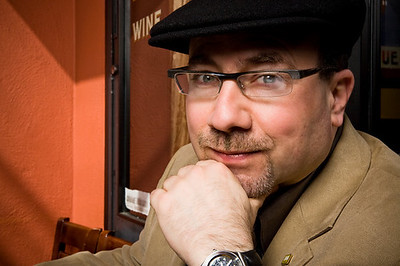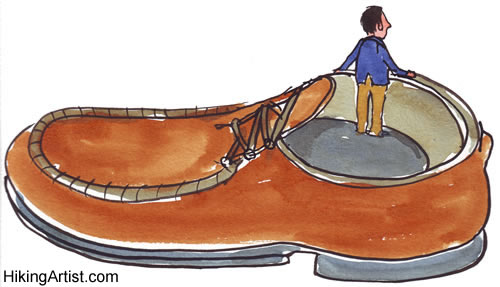|
|
|
Monday, March 9th, 2020

Poking through 14+ years of posts I find information that’s as useful now as when it was written.
Golden Oldies is a collection of the most relevant and timeless posts during that time.
Jack Welch died recently and Jeff Immelt is also gone from GE, but at the time, they were a good example of two sides of corporate responsibility — one who talked and the other who walked.
Read other Golden Oldies here.
If you’re a long-term reader you’ll know that I’m not a big fan of Jack Welch, while I am of Jeff Imelt—two guys with very different MAP.
Knowledge@Wharton made this comment as background in describing what Judy Hu, global executive director for advertising and branding, is doing to publicize the “new” GE.
Since becoming boss in 2001 — just a few days before September 11 — Immelt has aimed to make GE not only an innovator but also an environmental leader. In doing that, he has broken with his predecessor, Jack Welch, but also, in some ways, taken the company back to its roots. Thomas Edison, inventor of the light bulb and the phonograph, started GE in the late 1800s. More recently, under the combative, controversial Welch, it came to be known for operational excellence and a brassy pugnacity.
Welch famously declared that GE would have to be no. 1 or 2 in every line of business in which it competed and would ditch divisions where it wasn’t. And he battled state and federal regulators for years over their order that GE clean up carcinogenic waste that its factories had dumped into New York’s Hudson River. Under Immelt, the company hammered out an agreement to dredge the still-polluted river bottom. “Jeff said, ‘We’re going to fix that and move forward,’”
I find this ironically amusing after reading various articles where Welch was talking about corporate responsibility.
Corporate responsibility is a major buzzword these days, but it’s hard to tell whether it’s tied more closely to
-
- doing what’s right;
- doing what you can get away with; or
- just not getting caught.
Image credit: Willem van Bergen
Posted in Culture, Leadership | No Comments »
Wednesday, February 26th, 2020

Is anyone in tech truly immune from the lure of the big bucks that come from mining user data?
Not just in the short haul, but over the long haul — like 25 years?
Certainly not Google, with its management-trashed “don’t be evil.”
Or Facebook, that continually violates its users in the name of revenue.
but there is one site known to techies and the rest of us alike.
Craigslist.
Craigslist started as an email listserv in 1995, when early web enthusiasts were looking for a sense of community and DIY education. By 1996, it had become a website with job listings, apartment rentals, and personal ads. Almost as soon as the internet was becoming widely available—roughly 1 out of 5 households was online at the time—Craigslist was there to help people find roommates, look for jobs, go on blind dates, or sell used furniture.
Craigslist CEO Jim Buckmaster has been at the helm since 2001, and the founder, Craig Newmark, is still involved in the company. For years, Newmark did customer service, responding to design complaints and concerns about scams. Today, Craigslist has more monthly page visits than The New York Times or ESPN, and it’s been incredibly profitable.
Its profitability might come as a surprise to some. Many of those I spoke with thought Craigslist was a nonprofit or that it was community-run. In fact, Craigslist has always charged money for certain ads, such as job postings and classified ads. (By siphoning revenue from classified ads, Craigslist has been one reason newspapers across the country have struggled to stay in business.)
More recently, Craigslist has started charging for other kinds of ads, such as real estate listings from firms and car ads from dealers.
But regular users don’t have to pay a fee. The site doesn’t display banner ads, nor does it sell user data to third parties.
Way back when Craigslist was a startup I met Craig and found him to be a very nice, unassuming guy and it seems he’s still the same, as reflected in a 20017 interview.
“Basically I just decided on a different business model in ’99, nothing altruistic,” he said. “While Silicon Valley VCs and bankers were telling me I should become a billionaire, I decided no one needs to be a billionaire — you should know when enough is enough. So I decided on a minimal business model, and that’s worked out pretty well. This means I can give away tremendous amounts of money to the nonprofits I believe in … I wish I had charisma, hair, and a better sense of humor,” he added in a completely deadpan voice. “I think I could be far more effective.”
Current entrepreneurs seem more focused on charisma, hair, and reaching unicorn status via multiple rounds of investment. A sense of humor is considered optional.
Image credit: Cambodia4kids.org Beth Kanter
Posted in Culture, Leadership, Role Models | No Comments »
Friday, February 8th, 2019

A Friday series exploring Startups and the people who make them go. Read all If the Shoe Fits posts here.
I love the story of startup Be My Eyes, because it highlights an entrepreneur who really is changing the world and illustrates the good that comes from a lack of funds.
I read the story in the Lean Startup blog and thought it worth sharing.
“Be My Eyes is just a simple app that basically makes a video call between two persons (…) we have volunteers who sign up and say ‘Yes, I am available to help a blind person see something.’”
The volunteer presence adds an extra layer of independence to the visually impaired person’s life, rather than worrying that they are interrupting or imposing on someone.
All the volunteers do it look at their screen and tell the caller what they see, such as the ingredients in a recipe.
Be My Eyes boasts a global network of volunteers speaking a variety of languages and is always recruiting more.
The great thing is the volunteers can respond from wherever they are and the calls only take a few minutes. If they can’t take the call, no problem, since the system calls multiple people for each request.
Be My Eyes has a number of programs to encourage company involvement, including a way to provide product support to vision impaired/blind customers. This is a great opportunity for startups that want to give back, but have neither time or money to donate.
As to the advantage of minimal funding, it kept them from the typical tech error of over-engineering and forced them to keep the app very simple. Good move.
They had an overly long list of features they wanted to put into the app in the beginning, but which lack of funds prevented. (…) Be My Eyes hasn’t had many requests for all the “brilliant ideas” they had in the beginning. “So maybe it was a really good thing we didn’t overload the app.”
Be it as an individual or involving your family, friends or company be someone’s eyes, you’ll be amazed at the difference doing so will make in your life, as well as theirs.
Image credit: HikingArtist
Posted in Entrepreneurs, If the Shoe Fits, Innovation, Role Models | No Comments »
Monday, November 12th, 2018

Poking through 11+ years of posts I find information that’s as useful now as when it was written.
Golden Oldies is a collection of the most relevant and timeless posts during that time.
This story about Slack is from 2015.
Any company that follows in Slack’s shoes still warrants major media coverage.
Sad, isn’t it.
Read other Golden Oldies here.
A Friday series exploring Startups and the people who make them go. Read all If the Shoe Fits posts here
Being a woman in tech can be a serious drawback in 2015; far more so than in the 1980s and 90s — Tinder even dumped a woman founder on the basis that the company wouldn’t be taken seriously by investors. Sadly, they may have been right.
Leave it to Slack, valued at $2.8 billion, to do things differently.
According to its diversity report released on Wednesday, 45% of all Slack managers are female, with 41% of the entire workforce having a woman as their manager. “This means that 41% of our people report to a woman who helps set their priorities, measure their performance, mentor them in their work, and who make recommendations that will impact their compensation and career growth.” In non-engineering positions, 51% of the workforce turned out to be female. Out of the roughly 250 employees worldwide, 39% are reported to be female.
Slack is considered the fastest growing software company in history and they certainly lead the tech pack In gender diversity.
And while their racial diversity stats are as dismal as the rest of tech they are far more actively working on changing that, too.
Here are the company’s four hiring guidelines,
- Examining all decisions regarding hiring/recruiting, promotion, compensation, employee recognition and management structure to ensure that we are not inadvertently advantaging one group over another.
- Working with expert advisors and employees to build fair and inclusive processes for employee retention, such as effective management education, company-wide unconscious bias training, ally skills coaching, and compensation review.
- Helping to address the pipeline issue with financial contributions to organizations whose mission is to educate and equip underrepresented groups with relevant technical skills (like Hack the Hood and Grace Hopper), as well as supporting a variety of internship programs to broaden access to opportunity (like CODE2040).
- Attempting to be conscious and deliberate in our decision-making and the principles and values by which we operate. Changing our industry starts by building a workplace that is welcoming to all so that a generation of role models, examples and mentors is created.
Slack is practicing what recent studies have proven; hiring women pays.
Give that some thought the next time your unconscious bias kicks in leading you to reject a candidate because she is a she.
Image credit: HikingArtist
Posted in Compensation, Culture, Golden Oldies | No Comments »
Wednesday, April 25th, 2018
 Backstage at the Crunchies 2013. Photo by Max Morse for TechCrunch. Today was crazy (the aftermath of having a tree fall on your house) and I don’t have time to write a full post.
That said, I want to share an article on how individuals can band together to start changing a negative to a positive.
I hope you find The 36 Women Secretly Breaking Up Silicon Valley’s Old Boys’ Club as interesting as I did.
Now look around your little corner of the world and see where you can make a difference, too.
Image credit: TechCrunch via Wilimedia
Posted in Role Models | No Comments »
Wednesday, December 27th, 2017

Just a few days left this year, so I thought it would be a good time offer up some wise words for the coming year — actually, they are wise any time and any year.
I rarely quote those who cultivate guru status, but this from Craig D. Lounsbrough really resonates. It’s something many of our so-called leaders should embrace.
“An exceptional future can only be built on the transformation of the mess I’ve made out of my past, not the elimination of that mess.”
We all have messes, some worse than others, so stop minimizing yours or offering glib apologies and mea culpas.
Alan Cohen reminds us that there is no “right” time to start, including New Year’s.
Do not wait until the conditions are perfect to begin. Beginning makes the conditions perfect.
Beginning opens the door to success, but also to failure — or does it? (I got into a lot of trouble for this post, but I still stand by it.)
There is no failure except no longer trying. —Elbert Hubbard
Finally, a few words from two folks who have forgotten more about succeeding than most of us will ever learn.
Unlike Jeff Bezos, Tony Hsieh does a great job channeling many of Henry Ford’s attitudes. While Bezos is devoted to “delighting customers” and taking care of his professional employees, the same can’t be said for the rank and file.
A business absolutely devoted to service will have only one worry about profits. They will be embarrassingly large.
Finally, it seems that too many founders and investors have forgotten, if they ever knew, what drove Thomas Edison’s inventing.
I never perfected an invention that I did not think about in terms of the service it might give others… I find out what the world needs, then I proceed to invent it.
Useful thoughts and good guidance no matter when or where you are in your life.
Image credit: Eddy Van 3000
Posted in Personal Growth | No Comments »
Saturday, November 4th, 2017
A Friday series exploring Startups and the people who make them go. Read all If the Shoe Fits posts here.
 Winning takes many forms, as Ryan pointed out yesterday. Winning takes many forms, as Ryan pointed out yesterday.
Let’s face it, we are not all going to be the next Elon Musk or Jeff Bezos.
But there seems to be plenty of room for us all to push a bit harder each day and surround ourselves with winners.
It is up to us to make that happen.
Not all winners desire to be founders anymore than all founders are winners.
I doubt anyone would/could/should minimize the abilities, skills, intelligence, and sheer grit that lands a person in a top senior role at a multibillion dollar tech company, such as Microsoft.
Achieving positions at that level are neither accidental nor serendipitous.
Now, imagine a future in which you are a winner of whatever kind and writing the summary paragraph of your LinkedIn profile.
What would you say when summing up what you did and how you accomplished it? What would you consider your major accomplishments?
Would it read anything like this? (Emphasis mine.)
“I am passionate about building technology that gets out of the way so you can focus on what matters most. My mantra ‘people first, technology second’ has been the driving force in my career. My focus has been leading teams and incubating new technologies and experiences to re-imagine the platform for intelligent work. In my career, I’ve helped build products, including Office, Windows, Internet Explorer, Xbox and Surface, that touch more than a billion people every day. As a leader, it’s important that my door always be open — to embrace everyone’s individual perspective, personality, style and abilities to makes my teams stronger — and creating a culture that the best ideas can come from anyone and anywhere.”
Is this someone worth emulating? Someone you’d want to hire?
Would your answer change when you learned this someone is a woman?
Because it is; she is Julie Larson-Green.
And it is the last 14 words of her summary that truly proclaim her a winner — by any standard.
Image credit: HikingArtist
Posted in If the Shoe Fits, Personal Growth, Role Models | No Comments »
Monday, July 31st, 2017
It’s amazing to me, but looking back over more than a decade of writing I find posts that still impress, with information that is as useful now as when it was written.
Golden Oldies are a collection of what I consider some of the best posts during that time.
Heroes. Humanity has always had heroes. While it’s doubtful that will ever change, what constitutes a hero has changed radically over the centuries. I wrote this post in 2009, as the trend of elevating the most inane individuals, and even the dregs of society, to hero/role model status. As the old saying goes, something’s got to give.
Read other Golden Oldies here.
 Last Friday I wrote Narcissism and Leadership and how much narcissism has increased over the last few years. Last Friday I wrote Narcissism and Leadership and how much narcissism has increased over the last few years.
I’ve never understood the preoccupation with the glitterati, but I have wondered how much our celebrity-worshiping culture affects kids?
According to Drew Pinsky MD, AKA, Dr. Drew on radio and TV, and S. Mark Young, a social scientist it may be especially dangerous for young people, who view celebrities as role models.
“They are the sponges of our culture. Their values are now being set. Are they really the values we want our young people to be absorbing? … It harkens back to the question of how much are young people affected by models of social learning. Humans are the only animals who learn by watching other humans.”
Worse than dysfunctional celebs is our penchant for making heroes out of the bad guys.
18 year-old, 6-foot-5, 200-pound “Colton Harris-Moore is suspected in about 50 burglary cases since he slipped away from a halfway house in April 2008. Now, authorities say, he may have adopted a more dangerous hobby: stealing airplanes.”
Adin Stevens of Seattle is selling T-shirts celebrating him and there is a fan club on Facebook.
I’m not surprised, in a world where serial killers have groupies and people fight for souvenirs of death-row inmates it figures that they’re going to romanticize someone who manages to not get caught.
But what makes me ill are his mother’s comments, “I hope to hell he stole those airplanes – I would be so proud,” Pam Kohler said, noting her son’s lack of training. “But put in there that I want him to wear a parachute next time.”
It’s tough enough to grow up these days; it’s tougher in a dysfunctional home or in areas that are gang-controlled, but what kid stands a chance with parents like this?
What can we do? Where can we find more positive role models that have the glamour that mesmerizes kids and grownups alike?
When will we glorify function instead of dysfunction? Meaning instead of money?
Image credit: Chesi – Fotos CC on flickr
Join me tomorrow for Wally Bock’s take on heroes and how they need to change.
Posted in Ethics, Golden Oldies, Personal Growth | No Comments »
Wednesday, January 25th, 2017

In 1914 Henry Ford doubled his workers’ daily wage, much to the consternation of other magnates, who believed, as do most of them today, that success comes from paying as little as possible.
Ford, however, believed that he would benefit if his workers had disposable income and he was correct; they used the extra money to buy Fords.
The same holds true today; modern research has proved that higher wages increase profits.
Businesses, from very large to very small, still don’t believe it and scream at the thought of a so-called living wage.
But not all of them.
Fusion OEM at just $12 million is considered very small, but it’s profitable and founder Craig Zoberis is very happy, because he is meeting his twin goals.
While lots of other manufacturers have moved operations to China or Mexico, Zoberis has kept his plant in the United States – and considers it a point of pride to pay his 55 workers above-market rates. Workers with no experience start at $14-an-hour, he says, and by completing training and gaining skills can reach $18-to-20-an-hour, plus overtime and bonuses, for total pay near $50,000 a year, within a few years.
Zoberis doesn’t expect his people to buy his products, but he did want to have a place to work that matched his MAP and not his father’s.
My father and his partner never did a good job of hiring the right people with the right attitude. I wanted to be excited to go to work every day, and working for my father’s company, I was not.
Fusion OEM has never had a layoff, but finding great workers in its industry is just as difficult as finding great programmers, hence the need for a creative, long-term solution.
My colleagues were always complaining that there aren’t enough skilled workers who have the right attitude. When I talk about skilled workers I’m talking about machinists (…) What we discovered halfway through our life at Fusion is that we couldn’t always look outside for skilled people. We decided to hire for attitude and train for aptitude.
Fusion OEM is enjoying double digit growth, but Zoberis isn’t interested in taking outside investment. He loves going to work, saying, “This is my hobby, my income, my life,” and knows that hyper growth can kill you.
You can’t grow your company any faster than you can get the right people. If it goes too far, you might go beyond your capabilities and you’ll fail.
The interview is well worth reading, especially their approach to hiring and compensation.
I rarely make predictions, but in this case I feel pretty safe making two.
- Zoberis will continue building his company, growing his own people and being a management outlier.
- Most companies of whatever size will continue to treat people as disposable, pay them as little as possible and bitch about them to whomever will listen.
Image credit: Fusion OEM
Posted in Hiring, Motivation, Personal Growth, Retention, Role Models | No Comments »
Friday, April 15th, 2016
A Friday series exploring Startups and the people who make them go. Read all If the Shoe Fits posts here
 It’s a short post today, because there are a number of links well worth reading. It’s a short post today, because there are a number of links well worth reading.
Way back in 2008 I wrote It’s the People, Stupid, about the value of taking care of your people, as exemplified by Zappos, Costco and Trader Joe’s.
I’ve written many posts citing Walmart’s chew-them-up/spit-them-out lack of care and how banks, Yelp, HubSpot and Nest, among others, are following the Walmart model.
Dan Lyons, who spent two years at HubSpot, has written a book about his experiences called “Disrupted: My Misadventure in the Start-Up Bubble.”
You can get a sense of how HubSpot chews and spits from his opinion piece in the NY Times.
The upshot of all this is that you, as a founder, have a choice as to which model you’ll emulate.
Walmart or Zappos.
Just understand that you can’t switch from one to the other based on the employment market or your mood.
Image credit: HikingArtist
Posted in Culture, If the Shoe Fits | No Comments »
|
 Subscribe to
Subscribe to
MAPping Company Success
About Miki 
Clarify your exec summary, website, etc.
Have a quick question or just want to chat? Feel free to write or call me at 360.335.8054
The 12 Ingredients of a Fillable Req
CheatSheet for InterviewERS
CheatSheet for InterviewEEs™
Give your mind a rest. Here are 4 quick ways to get rid of kinks, break a logjam or juice your creativity!
Creative mousing
Bubblewrap!
Animal innovation
Brain teaser
The latest disaster is here at home; donate to the East Coast recovery efforts now!
Text REDCROSS to 90999 to make a $10 donation or call 00.733.2767. $10 really really does make a difference and you'll never miss it.
And always donate what you can whenever you can
The following accept cash and in-kind donations: Doctors Without Borders, UNICEF, Red Cross, World Food Program, Save the Children
*/
?>About Miki
About KG
Clarify your exec summary, website, marketing collateral, etc.
Have a question or just want to chat @ no cost? Feel free to write
Download useful assistance now.
Entrepreneurs face difficulties that are hard for most people to imagine, let alone understand. You can find anonymous help and connections that do understand at 7 cups of tea.
Crises never end.
$10 really does make a difference and you’ll never miss it,
while $10 a month has exponential power.
Always donate what you can whenever you can.
The following accept cash and in-kind donations:
|









 Winning takes many forms, as Ryan pointed out yesterday.
Winning takes many forms, as Ryan pointed out yesterday. Last Friday I wrote
Last Friday I wrote 
